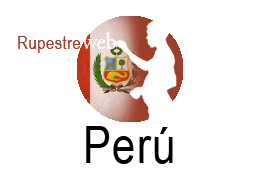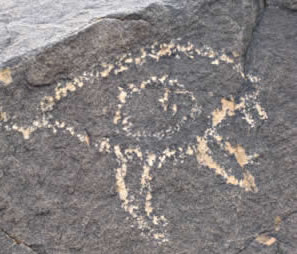 Andean
rock art and apophenia: from the macro to the micro Andean
rock art and apophenia: from the macro to the micro
Maarten van Hoek rockart@home.nl
Introduction
With great interest I have read the various internet
messages in the ROCK-ART List by Johnny Rubio Sosaya (2011) involving the
phenomenon of pareidolia and the
subsequent commentaries by several people on the ideas and suggestions put
forward by Johnny. In a nutshell, Johnny Sosaya, a
professional land surveyor, argues that rock art was ‘not
randomly engraved on rock surfaces, but in fact placed there by prehistoric men
where their imaginations were enchanted by representative images they saw on
the natural geological landscape, or panel. Like the images some of us see on
cloud and rock formations, so did ancient individuals see such images’ (Sosaya 2005). In this paper I will investigate this phenomenon within an Andean
context in order to attest the validity of his claims. But first it will be necessary
to separate and explain two terms.
Pareidolia is a psychological phenomenon
involving a vague and random stimulus (often an image or sound) being perceived
as significant (Wikipedia),
while apophenia is the
experience of seeing meaningful patterns or connections in random or
meaningless data (Wikipedia).
If I interpret these two definitions correctly, pareidolia seems to involve the internal stimulus (which is neurological), while apophenia concerns the external result of that stimulus, which
produces the - often subjectively created - interpretation: the image.
Therefore, it seems to be more correct to speak of apophenia when somebody
points my attention to a rock formation that in his or her mind resembles a ‘face’,
at least, when I also ‘recognise’ that rock formation as a ‘face’. I now argue
that the result of apophenia can be transmitted to other people.
In this way a
Peruvian tour operator once drew my attention to a bottle-shaped formation on
the west facing slope of ‘Cerro Botella’ in the Chicama Valley of northern Peru
(the name ‘Cerro Botella’ probably is a local ‘invention’; the name itself is
untraceable on the maps that I have available). On the slope of the hill side indeed
is a natural area of darker material that is shaped like a bottle (botella). It is even visible with Google
Earth: 727859.42 m O - 9155982.08 m Z). Although ‘Cerro Botella’ is situated
between two rock art sites (Cerro Negro to the SE and La Firma del Diablo to
the north), any link between the two (rock art sites and the natural formation)
is imaginary; the ancient Andeans probably did not know this type of bottle and
therefore may not even have noticed this particular natural shape, or perhaps
they have interpreted it completely differently. But this does not mean that
there never is a link between rock art and natural rock formations. In this
paper I will explore whether the effect of apophenia may have triggered rock
art production and whether it also occurs in the rock art itself.
Several articles have been written about the
subject of pareidolia and ([Andean]
rock) art (for instance Bustamante 2006, 2007 and 2008; Bustamante et al. 2011;
Campana Delgado 2004; Meschiari 2009; 2011). But it is not my intention to
review or comment all aspects of this interesting subject here. However, one
comment on the messages by Johnny Sosaya drew my attention. Allan Dart (2011) notably
commented ‘I do not consider such
formations to be in the same category as human-created symbols and art, or to
be very useful for interpreting why humans create such symbols.’. I definitely agree with Allan Dart that
natural rock formations are not ‘in the same category as human-created symbols
and art’, but I refute the idea that those natural rock formations cannot ‘be very useful for interpreting why humans
create such symbols’. His comment seems to me as ‘closing an interpretative
door (shut?)’. On the contrary, I argue that natural rock formations (no matter
the scale) can be appreciated and accepted by both individuals and cultural groups as if these formations belong to
their culture. I am certain that this also happened in prehistoric times, and
for several reasons this process was much more powerful than in modern times.
Today we often regard instances of pareidolia as ‘fun’. To many ancient peoples
the phenomenon probably was an important part of their religion and cosmology.
A ‘face’ in a rock formation in modern times will be more likely accepted as a
‘pun’, while the identification of the same ‘face’ in prehistoric times most
likely will have had a high degree of religious relevance and may often have been
‘fear-generated’.
I personally think that - in various postings
on the internet - Johnny Sosaya has offered enough graphic material to make it
most acceptable that there are links between rock art production and natural
rock formations (no matter the scale). In this respect it is also irrelevant to
me whether such associations are ‘individually’ or ‘culturally’ generated or
explicable. In my opinion those two factors can never be separated; both
factors (together with ergonomics and possibly other dynamics) determine the
final result (selection of the image, the stone, the site etc.).
Having said this I would like to consider
several natural rock formations that are associated with rock art in the Andes
of South America. In this review I argue that such associations may occur on
macro-level (the landscape the rock
art site is found in), on meso-level (the shape of the rock itself) and on micro-level (natural details on parts of the rock surface). In this paper I only offer a
selection of cases. There certainly will be many more instances that are still
unknown (to me) or have not yet been recognised.
Of course, especially the macro- and meso-levels
are subject to - literally and metaphorically - the point of view of the
observer. Literally, as from one angle the effect of apophenia will be visible, while observing the same spot or stone from
another angle will reveal nothing special.
Thomas Munro (1970: 344) called this ‘single-viewpoint realism’ or
‘single-viewpoint perspective’, which is described by him as ‘the ability to represent a scene as if
perceived as a whole from one point in space at one moment of time under one
set of atmospheric and lighting conditions’.
Metaphorically,
because it is the mind of the observer who ‘determines’ (both on individual
basis and because of cultural influences) what he or she ‘sees’ - or perceives
- in a certain natural rock formation. It is not to me to judge what another
person perceives in a rock formation. What he or she sees, is what he or she
sees. What I can do however, is to access the
degree of probability that indeed the manufacturer of the rock art also has seen the ‘same’ or ‘similar’ image in a rock formation
and that he or she selected that very spot and/or rock (panel) for his or her
‘rock art’ for that specific reason. It is important to realise that, although
both the manufacturer and the modern observer may literally have seen a ‘bird’
in a rock formation or in an arrangement of rocks, this does not mean that the
metaphorical content will be the same.
The Macro-level
In the Andes (and
elsewhere) many natural rock formations may be recognised, or rather
interpreted as humans (Hostnig 2010: Plate 560) or (human) faces (Hostnig 2010:
Plate 597), penises (Hostnig 2010: Plates 562; 593), animal shapes (Hostnig
2010: Plate 576) or whatever one thinks to recognise. Importantly, apophenia
very often seems to recognise ‘faces’ in whatever ‘chaotic’ medium in favour of
other pictures. Consequently, several examples of a ‘Cara del Inca’, or, alternatively, a ‘Rostro del Cristo’, have been reported in the Andes. As many of
those instances have been reported in or very near the river valleys in the
Andes, it is logical that also rock art may be present nearby. This combination
occurs for example in the Majes Valley of southern Peru. The Majes Valley is
very rich in rock art (for example at Toro Muerto and Alto de Pitis). Just north
of the town of Aplao is an example of a naturally formed ‘Rostro del Cristo’ (Panoramio), but I refute
that there is any connection between the prehistoric rock art of the area and
this modern example of apophenia.
This does not mean
however that - in general - ancient people have not been attracted by specific
features in the natural landscapes and consequently executed their images into
or onto the rock surfaces of the area because
of the specific shape of the landscape or their individual rock formations.
For instance, the petroglyph site of La Laja in the Majes Valley (opposite
Aplao) overlooks an impressive ‘field’ of rock pinnacles. Unfortunately such a
connection - as with La Laja - can never been proven, also as there are too few
(reported) instances that prove such a connection. What I am concerned about
however, is the degree of probability.
Interestingly, in
several cases the probability of intent is very high. In one of his letters on
the internet Johnny
Sosaya (2011) included a photograph of (part of) a landscape in New Mexico, in
the SW of the USA. It concerns a cliff face in Chaco Canyon which features
three ‘caves’ that are so ‘arranged’ that the whole assembly will immediately
be interpreted as a ‘face’ by most people (the adjacent rock formation to its
right - seen from the observer - may also be regarded as a ‘face’).
Importantly, the ‘mouth-cave’ and a rock panel to its left have been adorned
with petroglyphs. This ‘face’ literally (and metaphorically?) overlooks the
ruins of an ancient settlement. Because of his special interest in the subject Johnny
Sosaya intentionally and specifically photographed this
‘face’ at Chaco Canyon as early as 2005 (Figure
1). This does not mean however that he has also been
the very first person to appreciate the arrangement as a ‘face’. Most likely
the manufacturer(s) of the petroglyphs preceded him. Also the petroglyph panel
to the left of the ‘mouth’ has been interpreted as a ‘face’ by Johnny
Sosaya, but I regard this as a (possible) example on meso-level.
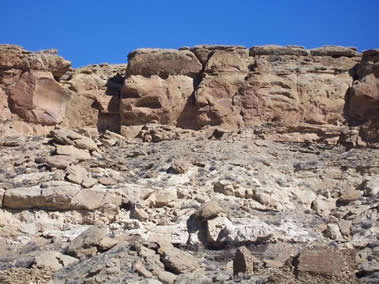
Figure 1. Sandstone cliff in Chaco Canyon, New Mexico,
USA.
Photograph
(2005) by J. R. Sosaya.
I would like to offer a similar instance of the
macro-level in the Andes. West of Cajamarca in northern Peru is the impressive
landscape of Cumbemayo, consisting of a ‘forest’ of rock pinnacles and other
formations. One of those rock formations - Cerro
del Santuario de Cumbemayo - can be perceived as a huge ‘face’ with ‘eyes’,
‘nose’ and a ‘mouth’. Peruvian archaeologist Ignacio Alva Meneses has aptly labelled
this rock formation ‘La Cabeza del Indio’
- the ‘Head of the Indian’ (Panoramio).
Importantly, the ‘mouth’ actually is a small cave or rock shelter - large
enough to allow an adult to stand upright - that has been lavishly decorated by
numerous petroglyphs (Núñez Jiménez 1986: 293). There are more caves or rock
shelters at Cumbemayo not forming a ‘face’, but - as far as I know - these have
not been reported to have rock art.
The Meso-level
The meso-level considers
the rock or rock panel as isolated from the landscape and the other stones in
the area. This means that the natural shape of a single boulder or the natural shape of a panel (or a series of adjacent panels) may trigger the effect of apophenia.
Besides the already mentioned point of observation, another factor often plays
an important role, notably the angle with which the sun (or moon) illuminates
the stone or panels, in which both illuminated parts and the dark parts
may play an equally important role.
A fine example is the ‘bird’s’ head at
Bogotalla in the Ingenio Valley of southern Peru (Van Hoek 2011c). Only from
one point of observation (only when viewed from the south) this rock (BOG-001) clearly
resembles a large, agnatic ‘bird’s’ head. All other points of view result in perceiving
‘meaningless’ appearances of the rock (at least to me). In addition to the
alleged biomorphic shape of the south face of the rock there is another
interesting feature. There is a large natural depression on the smooth surface
of the south facing panel. Remarkably, this depression looks like a large ‘eye’
(Figure 2), but only in combination
with the ‘bird’s’ head. Moreover, the light of the sun, especially at certain
times of the year and especially around noon, casts a dark shadow over the upper part of the natural depression,
creating the effect of an ‘eccentric pupil’ above the more clearly illuminated
lower part of the depression.
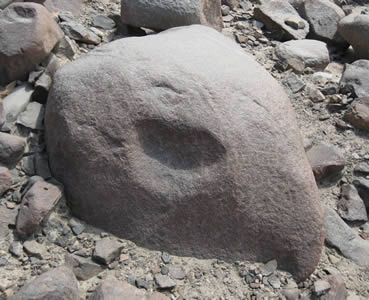
Figure 2. Petroglyph
Boulder BOG-001 at Bogotalla, Peru.
Photograph by Maarten van Hoek.
Two facts are important. In coastal desert
areas of the Andes birds (of prey) played an important role in the cosmology of
the ancient societies. It is therefore highly probable that an individual
‘perceived’ this boulder at Bogotalla (which is usually approached from the
south; from the valley) as a ‘bird’s’ head. There are more boulders in the
Desert Andes that may have been perceived as ‘bird’s’ heads. An example is the
well known ‘main’ petroglyph boulder at Quebrada de los Boliches in northern
Peru. This large boulder (BOL-001) has two natural depressions that seem to represent
the ‘eyes’ of a large, agnatic ‘bird’s head’ that appears to be situated in a
‘tilted’ position. However, only at a certain time (day and year) and on a
sunny day this ‘bird’s’ head is revealed (Figure 3). I have seen many photos of
this boulder that do not show this effect. Importantly, this boulder has
numerous petroglyphs on four panels, while the upper panel features a large ‘bird’
(!?) design that most likely dates from the Formative Period of this part of
the Andes (roughly from 2000 B.C. to A.D. 0). Also a large boulder (now
unfortunately severely damaged) at La Puntilla in northern Peru may have been
selected by the prehistoric petroglyph manufacturer because of the resemblance
with a ‘bird’s' head. Unfortunately I have not been able to locate this boulder
when I visited the site, but photos of this boulder can be found on the
internet ( Panoramio). Importantly, this ‘bird’s head’
effect can be appreciated from both sides. Moreover, the effect is enhanced by a large anthropic petroglyph of a
circle on both sides, located at the
spots where the ‘eyes’ would have been located.
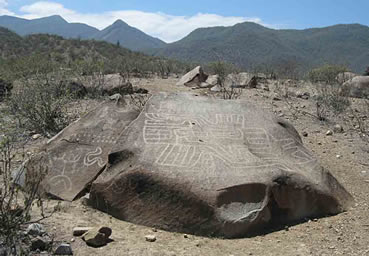
Figure 3. Petroglyph
Boulder BOL-001 at Quebrada de los Boliches, Peru.
Photograph by Maarten van Hoek.
Secondly, in the Formative Period of the
northern Andes, agnatic biomorphs
have frequently been depicted in many different contexts (rock art and architectural
art, ceramics etc). Possibly to confirm the recognition and significance of this ‘bird’s’ head, a prehistoric manufacturer
pecked out an agnatic (!) ‘face’ in the MSC-style (and some other petroglyphs)
on the face of the ‘bird’s’ head. The MSC-style - an acronym introduced by me
(Van Hoek 2011a) - is an iconographic style that is most characteristic for the
Formative period in the northern Andes - it usually and incorrectly is referred
to as the ‘Chavín-style’. This petroglyph production on Boulder BOG-001 seems -
at least to me - to be highly intentional and is firmly associated with the
‘bird’s’ shape of the south face. I also argue that - later - this sacred stone/site
was sanctified even more by the manufacturing of petroglyphs on several smaller
boulders that surround the ‘bird’s’ head.
An interesting analogy is found much further
north, at Cooks Peak in New Mexico, USA. In one of his messages on the internet
Johnny Sosaya (2011) claimed that a ‘configuration’ composed of specific parts
of a randomly arranged group of four boulders at this site could be interpreted
as a ‘bird’. At first sight all boulders involved seem to be amorphous, as well
as the natural arrangement of the four boulders. However, when illuminated by
the sun at a certain time, a concatenated series of small side panels, which
receive no sunlight, in combination
with the illuminated planes of the surrounding boulders, the ‘dark’ image of a
‘bird’ may be perceived (Figure 4). The effect of perceiving an image in this
randomly arranged group of boulders is what Robert Bednarik (2010: 263) probably would also label as ‘clustering
illusion’ (apophenia). Importantly, Johnny Sosaya informed me that there is only
one ‘vortex’ point within the field of view where the camera can be situated in
order to capture the image and that even the distance to the configuration is decisive
in order to fully appreciate the ‘bird’ (2011 pers. comm.).
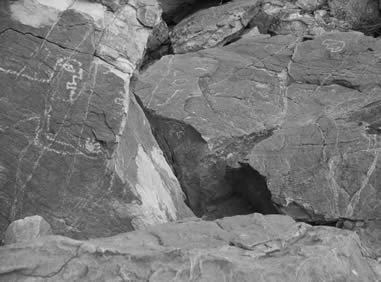
Figure 4. Petroglyph
boulders at Cooks Peak,
New Mexico, USA.
Photograph
by J. R. Sosaya.
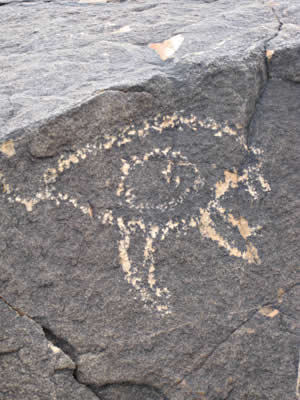
Figure 5. The ‘eye’
petroglyph on one of the boulders at Cooks Peak, New Mexico, USA. Photograph
by J. R. Sosaya.
In this discussion I consider it most important
that one of the rock panels that ‘compose’ the ‘bird’ bears a petroglyph that
is shaped like an ‘eye’ (Figure 5). Although the petroglyph may represent something
else because it has several short appendages (legs?) in the typical Jornada
Mogollon style, this does not distract from the point raised by Johnny Sosaya
that this arrangement of darker areas may represent a ‘bird’. Most important in
this discussion is the placement of the ‘eye’ petroglyph. It is notably placed exactly at the spot where the eye of the
‘bird’ could have been expected. This seems to indicate a high degree of intent
and simultaneously seems to confirm that the darker parts, seen from one
specific angle at a certain time of the day (and year) have been interpreted as
a ‘bird’ by the prehistoric manufacturer as well. Petroglyphs of ‘birds’ that
have similarly been drawn, occasionally occur in Jornada Mogollon rock art.
Possibly the ‘bird’ represents a ‘hummingbird’; creatures that in the SW of the
USA sometimes are associated with fertility and stillbirth (Slifer 2000: 130).
On the adjacent boulder is the petroglyph of a
laterally depicted anthropomorph, in a possible ‘praying’ position (Sosaya 2011),
part of which is visible in Figure 4. The whole ‘scene’ might be interpreted as ‘a person showing
reverence to a bird’. However,
associations between clearly separated rock art motifs are often hard to prove.
It is therefore not certain if indeed there is an association between the
‘bird’ and the anthropomorph. Although both the anthropomorph and the ‘bird’s
eye’ are definitely of Jornada Mogollon manufacture, they need not necessarily be
contemporary. However, discussing the Jornada Mogollon style rock art Polly
Schaafsma (1980: 199) argues that ‘Superimpositions
are not usual, and this factor, along with the decorative aspects of the
figures and their occasional placement in strategic locations for dramatic
effect, suggests that part of their function was in the viewing after their
manufacture’. These observations also point to a high degree of intent of
specific petroglyph production by the Mogollon people(s).
It proves that often it is decisive at what
time of the day a rock art site is being visited and that simultaneously one
has to be aware of the phenomenon of apophenia.
For instance, I have visited Alto de la Guitarra in northern Peru, but I
did not experience a single instance of apophenia
at that occasion. Moreover, at that time I was not aware of that possibility
that rocks could have been selected by prehistoric petroglyph manufacturers
because of the natural (biomorphic)
shapes of those rocks, even though (much) earlier I had many experienced
instances of apophenia at many other occasions (seeing ‘faces’ etc in all sorts
of media - tiles, trees, clouds etc). Unfortunately, at the time of my visit I
had no knowledge of the interesting publication by Cristóbal Campana Delgado (2004) in which he
reported several boulders at Alto de la Guitarra that are shaped like a ‘fish’,
a ‘toad’, a ‘serpent’, a ‘bird’s’ head and a ‘feline’. Several of those
boulders also bear petroglyphs. It is also necessary to mention here
that Alto de la Guitarra is a major petroglyph site with many MSC-style images
from the Formative Period.
Campana Delgado (2007) also describes a boulder
at Alto de la Guitarra that he perceived as a large agnatic ‘head’ with large,
shallow natural cavities in which petroglyphs of ‘eyes’ have been added at the
‘right’ places. Superimposed upon this ‘face’ is a large petroglyph of an
anthropomorph (El Prisionero del Tiempo)
of which one half is illuminated in the morning, the other half in the
afternoon. Campana Delgado was one of the first rock art investigators who
argued that specific stones in the Andes were especially selected to be
‘decorated’ with petroglyphs because of the natural (biomorphic) shape of those stones.
It seems that the ‘eye’ is an important feature
in (Formative Period?) Andean rock art production. This seems to be confirmed
by a most interesting boulder at Quebrada de Los Boliches in northern Peru.
This boulder (BOL-011) has a typical natural ‘pyramid’ shape (it is not a ‘menhir’
as suggested by Núñez Jiménez [1986: Fig. 26]). I suggest that this boulder has
been selected because of its resemblance with some of the surrounding mountain
peaks and in order to confirm this (possible) relationship the prehistoric
petroglyph manufacturer decorated the apex of the stone with at least seven
(possibly nine) concentric grooves. Other panels of the ‘mountain stone’ also
have petroglyphs. However, after having wandered around for some time at the
site, my wife Elles pointed out something remarkable to me. What seems to be
unnoticed up to now is the fact that the almost vertical south face of the
‘mountain stone’ (panel BOL-011A) features two cupules that are so arranged
near the top that they immediately give the impression of two ‘staring eyes’
(Figure 6). This effect is only visible at certain times of the day and year.
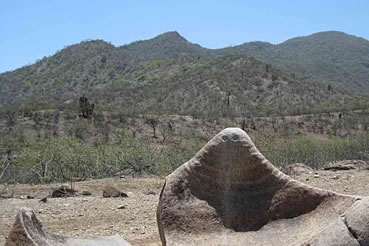
Figure 6. Petroglyph
Boulder BOL-011A at
Quebrada de los Boliches, Peru. Notice
the resemblance between the contour of the boulder and the mountain beyond. Photograph by Maarten van Hoek.
Another site in the north of Peru where the
‘eye’ may play an important role is Cerro Mulato, a huge site with possibly
millions of undecorated boulders. Although only a very small fraction of this
enormous collection of boulders on this small hill bears petroglyphs, more than
500 boulders have been recorded by me. Several of those images are of the
typical MSC-style. However, very few boulders (if any) seem to be selected
because of their biomorphic shape. Boulders definitely shaped like (part of) a
biomorph have not been recognised by me, although a few stones at Cerro Mulato might once have been appreciated ‘bird’s
(?) heads’. It concerns the possible profile ‘face’ of a ‘bird’ formed by the shaded parts of panel A of Boulder CMa-497,
while the large circle may have been intended to represent the ‘eye’ (Figure 7)
and the possible profile ‘face’ with a natural ‘eye’ on panel CMa-502 (Figure 8).
Boulder CMn-229 also may be perceived as a ‘bird’s’ head (Figure 9). It has
three areas with petroglyphs. The faint petroglyph placed in the purported ‘eye’
area might intentionally focus on the
‘eye’ of the natural biomorphic shape, but this is uncertain.
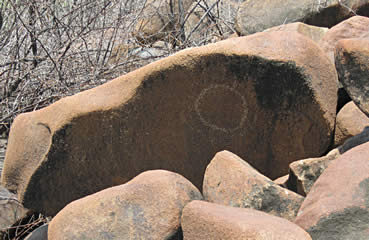
Figure 7. Petroglyph
Boulder CMa-497at Cerro Mulato, Peru.
Photograph by Maarten van Hoek.
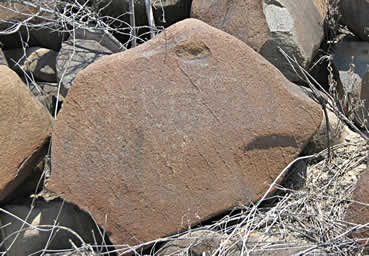
Figure 8. Petroglyph
Boulder CMa-502 at Cerro Mulato, Peru.
Photograph by Maarten van Hoek.
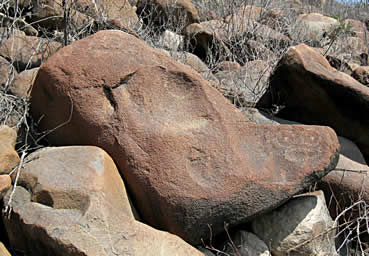
Figure 9. Petroglyph
Boulder CMn-229 at Cerro Mulato, Peru.
Photograph by Maarten van Hoek.
In an interesting article David
Ayasta Vallejo, Wilfredo Bastidas Vallejos & Lourdes Falla Vasquez discuss
at least three natural rock formations (litoesculturas) at Cerro Mulato that have been
‘recognised’ by them as the representations of a giant ‘fish’ (2011: Fig. 19), a
‘condor’ (2011: Fig. 17) and of a ‘feline’ (2011: Fig 26 and 27). Although they
claim that the ‘fish’ at Cerro Mulato is a unique example in northern Peru (‘es
un caso único de representación ictiológica en granito en el área andina’), they do not seem to have been aware of
the publication of Cristobal Campana Delgado (2007: Fig 6b) who previously
reported a ‘fish’-shaped boulder at Alto de la Guitarra. Unfortunately,
most of the photographs in their internet-paper (2011) are too small and too
blurred to be scientifically useful, and as I have not seen (or recognised)
those rock formations, I cannot warrant the authenticity of those three ‘litoesculturas’. Their findings only confirm that people often perceive zoomorphic
shapes in rock formations and this possibly confirms the relationship between apophenia and rock
art production (at least at Cerro Mulato).
Not far from Cerro Mulato is another
interesting rock art site called Las Piedras Negras. It has only a few
petroglyph rocks, but two boulders are possibly relevant. The Las Piedras
Negras site consists of two low eminences of greyish-black boulders/outcrops
(hence the name). The northern - and slightly higher - of the two hillocks also
has a number of reddish boulders at the NW side. One of those reddish boulders can
easily be perceived as a large ‘bird’s’ head. Remarkable is the large natural
depression that again will be perceived as the ‘eye’ (Figure 10). Although I
could only detect a very faint and doubtful petroglyph on its smooth surface
(above the curved ‘beak’), its proximity to definite petroglyph rocks may be significant.
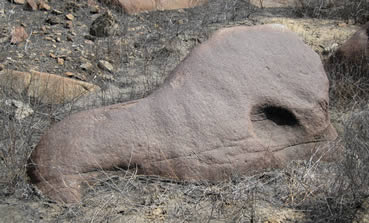
Figure 10. Boulder at Las Piedras Negras - El Progreso, Peru.
Photograph by Maarten van Hoek.
But there is more. When approaching the
northern eminence at Las Piedras Negras from the south one may encounter a
large grey in situ boulder with an
almost vertical, SW facing panel. This panel has a ‘bas-relief’ that very much
looks like the ‘framed’ profile depiction of a zoomorph (Figure 11). As I could
not see any anthropic markings on the rock surface (but I am not an professional
archaeologist and only rely on naked eye observations and photography), I
assume that this ‘zoomorph’ represents a natural formation. Yet the ‘image’ may have been worked on (beyond recognition, as the
rock art at this site is very old). It probably dates to the Formative Period
as well as at least three of the petroglyphs at this site again are of the
MSC-style (Van Hoek 2011a: 96; Fig: 92). It is not far fetched to suggest that
this ‘zoomorphic’ rock could have triggered the ancient petroglyph production
at this site, even when there is some distance between the ‘zoomorphic’ panel
and the major petroglyph concentration farther to the north, on the actual
hillock.
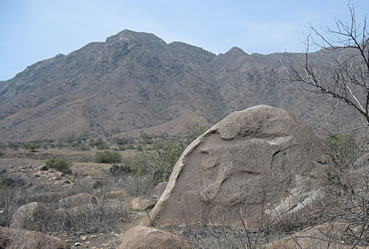
Figure 11. Boulder without
petroglyphs (?) at Las
Piedras Negras - El Progreso, Peru.
Photograph by Maarten van Hoek.
Additional ‘evidence’ at two other sites in
northern Peru seems to confirm the idea that natural rock formations and rock
art are associated. The first example
occurs at Tolón in the Jequetepeque Valley. This large, sandy area has at least
15 petroglyph boulders; most of these scattered wide apart. Importantly, most
of the petroglyph stones feature MSC-style designs that are clearly from the
Formative Period. At least 14 stones have been described by Bracamonte Lévano
& Pasapera Rojas. (2008), but they do not mention or illustrate an
undecorated boulder that shows an important aspect when is approached from the
SE. It is a large boulder with three large cavities on the vertical SE facing
surface that immediately give the impression of a ‘face’ (Figure 12). Although an
association of this ‘face’ with the petroglyphs at Tolón can never be verified,
it is remarkable that again a natural ‘face’ is found in a boulder field with Formative Period petroglyphs.
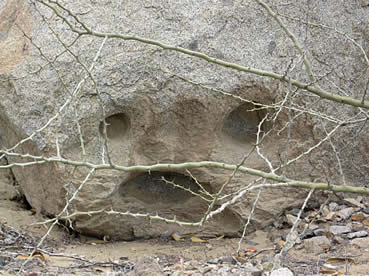
Figure 12. Boulder without
petroglyphs (?) at Tolón, Peru.
Photograph by Maarten van Hoek.
The second example is found at Yonán, an
important rock art site, also in the Jequetepeque Valley. When approaching the
site from the north (from the valley), a large formation of two rocks, one with two large cavities
is visible. These two stones form the very beginning of a chaos of boulders and
outcrop surfaces that bear hundreds of petroglyphs. The two adjacent cavities in
the uppermost boulder clearly form the ‘eyes’ while the dark part of a long,
decorated boulder further below may be interpreted as a ‘mouth’. Campana
Delgado & Deza Medina (2006: 59 - 60) describe the rock formation as
follows: en la parte más baja, donde hay
dos piedras superpuestas que conforman - casualmente - un rostro humano, al que
los lugareños lo conocen como ‘la calavera’ o ‘el mono’. For a good photograph
of this ‘monkey face’ I refer to Fig. 3 by Campana Delgado & Deza Medina
(2006). Importantly in the scope of this article is that I probably was the
first to report a small number of clearly MSC-style petroglyphs from the
Formative Period at this site (Van Hoek 2011a: 90; Fig. 82), while Campana
Delgado & Deza Medina (2006: Fig. 2) have illustrated an impressive
Formative Period MSC-style petroglyph at Cerro Yonán (a different rock art site
across the dry valley to the west of Yonán).
The Micro-level
On micro-level natural features on or in the rock surface are considered,
disregarding the shape of the whole boulder or panel. It is a fact that
prehistoric manufacturers of rock art sometimes included natural features into their anthropic designs (for an example at Checta, Peru, see Van Hoek 2010), but that is not
the same as recognising biomorphic shapes or other images in those rock
features as this practice does not involve the effect of apophenia. I hereby offer three
examples of natural features that seem to have been included into an anthropic
design (on purpose?) and will access their probability of being examples of apophenia.
On panel MIN-011 at Miculla (in the extreme
south of Peru) is the petroglyph of an anthropomorph with raised arms (Figures 13
and 14). Those arms seem to have been intentionally placed precisely below a
somewhat higher area of the boulder, thus creating the impression as if this
‘Atlas’ person is carrying the ‘world’ (my interpretations). To me this is not an example of apophenia (although it might have been to the manufacturer).
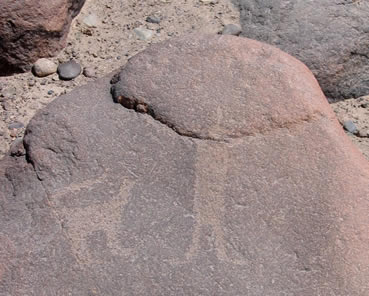
Figure 13. Petroglyph
boulder MIN-011 at
Miculla, Peru.
Photograph by Maarten van Hoek.
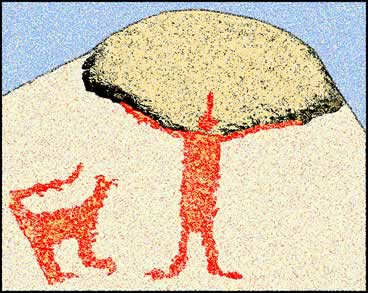
Figure 14. Petroglyph
boulder MIN-011 at
Miculla, Peru.
Drawing by Maarten van Hoek.
Somewhat more ambivalent is the petroglyph of
the ‘monkey’ on panel JUA-024 at Quebrada de San Juan in northern Peru. This
‘monkey’ image uses a small but natural raised area of stone as its ‘head’ (Figures 15 and 16). I have argued before
(Van Hoek 2007a) that this natural disc may have been worked on to produce a
more circular shape. I have also argued that possibly the ‘head’ originated
first and that the body of the ‘monkey’ was added at a later stage. It is
possible, but impossible to prove, that natural features (for instance small depressions) in the naturally formed disc were accidentally
so arranged that the impression of a ‘face’ originated. If this is so, then it
could be an instance of apophenia. The
prehistoric manufacturer could have recognised this potential as well and
turned the natural disc into a ‘face’, ‘head’ or ‘mask’. Although no certain Formative Period images of the
MSC-style occur at Quebrada de San Juan, only a few kilometres to the east is the Formative Period petroglyph
site of Tomabal with several fine MSC-style images (Van Hoek 2007b; 2011a).
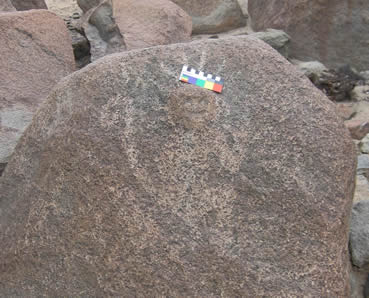
Figure 15. Petroglyph
boulder JUA-024 at
Quebrada de San Juan, Peru. Note: the
IFRAO-scale is not attached onto the rock surface, but is resting on the natural projection.
Photograph by Maarten van Hoek.
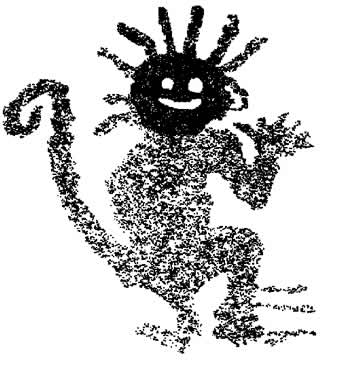
Figure 16. Petroglyph
boulder JUA-024 at
Quebrada de San Juan, Peru.
Drawing by Maarten van Hoek.
The only parallel to the Quebrada de San Juan
‘monkey face’ that I know of occurs in northern Chile. In the Quebrada Amarga,
a tributary to the Río Loa, are several interesting rock art sites that,
unfortunately, I have not seen myself. On one of the many vertical cliff faces at
Playa de Llamo is the sculptured head of a ‘face’, described by Diego Artigas &
Juan García (2010: Fig.
18) as follows: “Diseño de la cabeza de
una llama esculpido en la roca a partir de una protuberancia”. From their
description it may be inferred that a natural projection formed the basis of the ‘sculpture’.
However, most important in this discussion is
the site of Palamenco in the north of
Peru. Besides a few most interesting examples of the use of natural features,
like a natural hole forming the central part of a ‘solar’ petroglyph on Boulder
PAL-082 (Figure 17), there are a
few boulders that must be considered in more detail, especially as one boulder
offers definitive proof that
apophenia resulted in a most amazing petroglyph. Again it is important to
notice that Palamenco has several petroglyphs that definitely are of the
Formative Period MSC-style (Van Hoek 2011a).
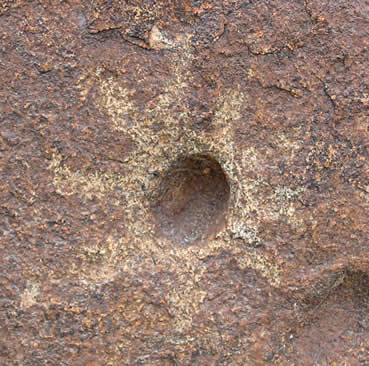
Figure 17. Detail of petroglyph
boulder PAL-082 at Palamenco, Peru.
Photograph by Maarten van Hoek.
Boulder PAL-103 at
Palamenco has a natural cavity that may have been incorporated on purpose to
create the design of a ‘pregnant (?) snake’, or a ‘snake’ that has ‘devoured a
prey’ (Figures 18 and 19). Important is that the edges of the natural depression have been accentuated with pecking
and that the interior has been adorned with a simple grid of pecked lines. With
some imagination this stone (Figure 18) can also be considered to represent a
‘bird’s head’ in which the accentuated natural depression may represent the
‘eye’.
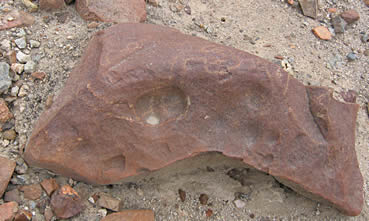
Figure 18. Petroglyph
boulder PAL-103 at Palamenco, Peru.
Photograph by Maarten van Hoek.
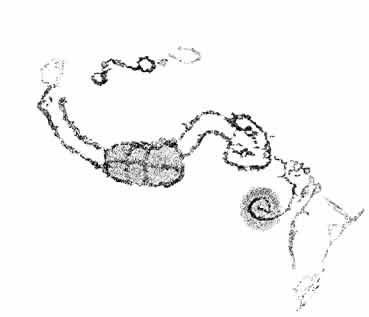
Figure 19. Petroglyph
boulder PAL-103 at Palamenco, Peru.
Drawing by Maarten van Hoek.
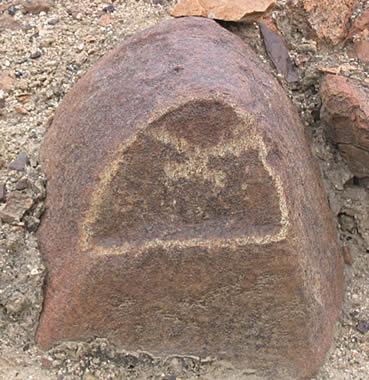
Figure 20. Petroglyph
boulder PAL-098 at Palamenco, Peru.
Photograph by Maarten van Hoek.
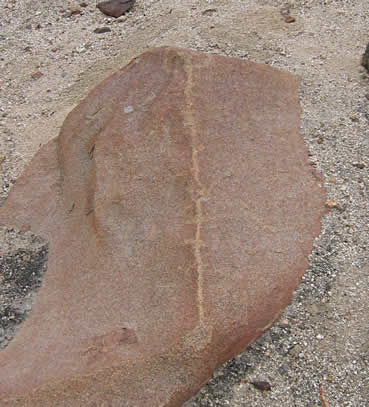
Figure 21. Petroglyph
boulder PAL-091 at Palamenco, Peru.
Photograph by Maarten van Hoek.
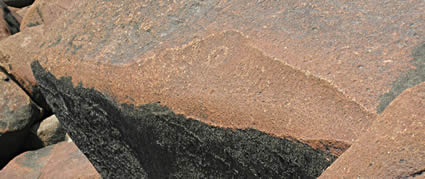
Figure 22. Petroglyph
boulder CMf-454 at Cerro Mulato, Peru.
Photograph by Maarten van Hoek.
Similarly, Boulder
PAL-098 has a simple design, but again the edges of the panel have been pecked on purpose (Figure 20), while the natural, linear crest on Boulder PAL-091 has apparently been used to create a ‘snake’ or ‘eel’
petroglyph (Figure 21). Also at
Cerro Mulato the practice of accentuating natural edges has been recorded by
me. Especially Boulder CMf-454 might have been engraved to represent a
biomorphic ‘head’, possibly of a ‘bird’ (?) (or even a ‘fish’?), while again
circles seem to represent ‘eyes’ (Figure 22).
It is this practice
to intentionally accentuate the edges of
natural features which offers the evidence that apophenia can be
responsible for petroglyph production. This proof is found on panel ‘A’ of Boulder
PAL-121 at Palamenco. This panel has been illustrated - probably for the first
time - by Núñez Jiménez as Piedra 118
(1986: 551 - note that four other petroglyph panels on this boulder are not
illustrated). Unfortunately his illustration is incorrect in two ways. Firstly,
Núñez Jiménez interpreted the design (1986: Fig. 1089) as a ‘bird’ (’ave’), while clearly the ‘configuration’
actually consists of an unrelated set of two concentric circles crowning the
apex of the boulder (in itself a recognition of the natural shape of the boulder -compare with Figure 6), a possible ‘zoomorph’,
a possible spiral and a few indistinct markings (Figure 23). These components need not necessarily be contemporary. Moreover, parts
of the ‘configuration’ clearly have been re-pecked, which is not visible in the
drawing by Núñez Jiménez. All these facts confirm my conclusion (Van Hoek
2011b) that 20% of the illustrations in the voluminous work by Antonio Núñez
Jiménez is incorrect/inaccurate and cannot be accepted as scientifically unfailing.
Secondly and most importantly, Núñez Jiménez did not include in his drawing the lower part of the boulder. And it is
exactly there - almost at ground level - where we can find the evidence.
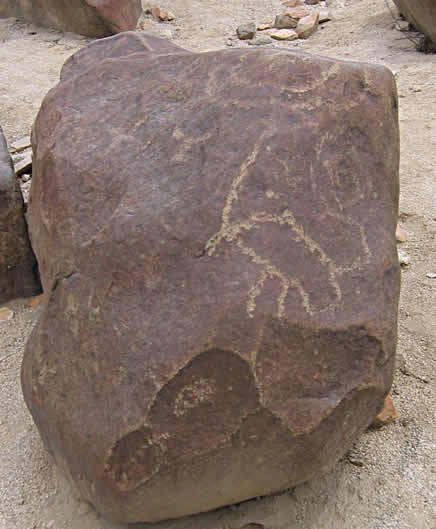
Figure 23. Petroglyph
boulder PAL-121, panel A, at Palamenco, Peru.
Photograph by Maarten van Hoek.
The lower part of panel
PAL-121A (Figures 24
and 25) notably consists of a concatenation
of three shallow, natural depressions. It is perplexing to see that the prehistoric manufacturer
recognised a ‘bird’s’ head in this series of three depressions. He or she
accentuated the edges of the depressions to outline the ‘head’, then added a straight,
internal line in the first depression in order to create a ‘beak’ and - most
importantly - finally added an ‘eye’ into the depression that formed the ‘head’
of the ‘bird’. I cannot imagine
that some-one would refute that this has been done completely intentional.
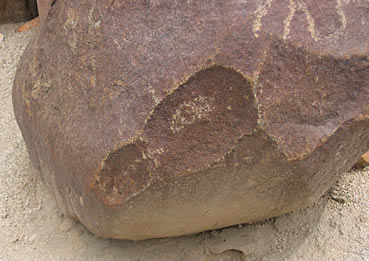
Figure 24. The lower
part of petroglyph boulder PAL-121, panel A, at Palamenco, Peru.
Photograph by Maarten van Hoek.
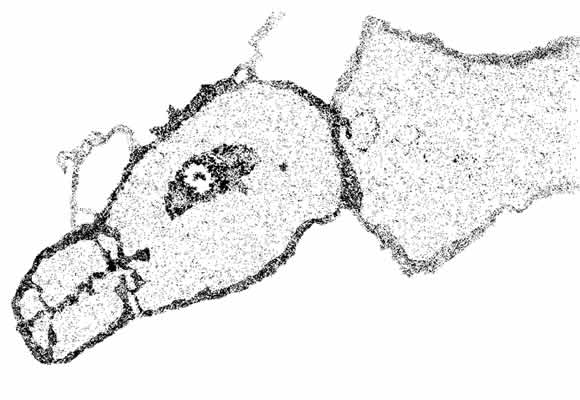
Figure 25. The lower
part of petroglyph boulder PAL-121, panel A, at Palamenco, Peru.
Drawing by Maarten van Hoek.
ConclusiOn
First of all, it is
impossible for us modern researchers to judge what prehistoric people have
perceived when they looked at a boulder, a rock panel or whatever natural
feature. What is definitely certain is that - in the case of Boulder PAL-121 at
Palamenco, Peru, - someone in the prehistory of the Andes recognised something specific
and relevant for him or her - a ‘bird’s head’ - in a series of natural shapes on a boulder and created
a petroglyph out of those natural features. For that reason I regard that
specific petroglyph to represent ‘apophenic’ rock art. The word ‘apophenic’
exists (see for instance Meschiari
2011), but is very rarely used. Yet I
would like to introduce the term here in association with rock art. ‘Apophenic’
rock art is rock art that originates from apophenic experiences. I am certain
that at least some of the other examples discussed in this paper may be
regarded as instances of ‘apophenic’ rock art on micro-level and that, moreover, apophenia on meso-
and macro-level may have played a (decisive?) role in the selection of a site
in order to sanctify the site and consequently to produce rock art there, even
when the ‘apophenic’ rock itself does not have rock art (like at Tolón - see
Figure 12).
In this paper I
discussed rock art sites like Quebrada de los Boliches, La Puntilla, Tolón,
Yonán, Alto de la Guitarra, Cerro Mulato, Las Piedras Negras, Cumbemayo and
especially Palamenco. These are all are sites in the north of Peru often with
marked Formative Period MSC-style imagery. And all those sites have a
(possible) ‘aphophenic’ association with natural features. Even in the south of
Peru is a Formative Period rock art site, Bogotalla, where there seems to be a
definitive link between early petroglyph production and apophenia. And probably
there will be more such sites in the Andes. Therefore, an important conclusion
- for Andean rock art in particular - may be that - regarding rock art
production - apophenia seems to have been especially effective during the
Formative Period in a specific part of the northern Andes. Another interesting
facet of this discussion is that Formative Period MSC-style iconography also
centred on the ‘head’ and the ‘eye’ as the most important features of a
biomorph (for more details see Van Hoek 2011a).
Indeed, most decisive
in accepting the ‘apophenic’ nature of the specific petroglyph on Boulder
PAL-121A at Palamenco, Peru, is the addition of an ‘eye’ petroglyph at the right spot into a natural depression. Also the addition of (MSC-style) petroglyphs
very near the natural ‘eye’ of the natural ‘bird’s’ head at Bogotalla,
Peru, confirms the importance of the ‘eye’. These (f)acts make the probability
that the same is true for the ‘bird’ configuration at Cooks Peak very high.
Although the ‘bird’ itself is not created by anthropic markings, the natural shape of the Cooks Peak ‘bird’,
formed by dark planes of several rock surfaces, is substantiated by the
manufacturing of an ‘eye’ petroglyph at the right spot.
I am sure that more
can and will be discovered in this respect, especially as many reports and
inventories only or partially have published the drawings of the petroglyphs,
disregarding or not describing the natural shape of the stone. Even when photos
are taken, they usually focus on the designs and hardly ever the complete
boulder is photographed and rarely from all sides. The observation of the shape
of boulders and panels should be a standard procedure, at least in Andean rock
art.
So, if we work back
the line of reasoning, because it proves that solid evidence for ‘apophenic’
petroglyph production on micro-level is available, it is most likely that also
on meso-level and on macro-level apophenia may have influenced the choice of
petroglyph production at certain sites, even when - in general - indications
for such a psychological process are very scarce. As a consequence it is almost
certain that the claims by Johnny Sosaya in his various
postings on the internet are legitimate. Although Johnny argues that ‘he limits his research to only rocks or
panels containing petroglyphs (2011)’, I, on the contrary, argue that also undecorated rocks formations should be taken into account. I
therefore invite rock art scholars to look at rock art sites - and at (decorated) boulders and at (decorated) panels in isolation -
with an unbiased, open mind, allowing for pareidolia and apophenia to be to a
certain degree responsible for at least part of the global rock art production,
no matter how small that part is.
Acknowledgements
I am grateful to Johnny Sosaya for all the (graphical
and textual) information that he kindly made available to me and for commenting
on the draft text. Also, Johnny was most helpful by providing me with several
high resolution photographs of the two relevant rock art sites, Chaco Canyon
and Cooks Peak, which I have not seen myself. These photos (Figures 1, 4 and 5)
have been reproduced here with his kind permission. All other photos and
drawings are by the author and are his copyright. Last but not least I am indebted to Rainer Hostnig for sharing his superb
book about Carabay (2010) with me.

—¿Preguntas,
comentarios? escriba a: rupestreweb@yahoogroups.com—
Cómo
citar este artículo:
Van
Hoek, Maarten. Andean rock art and apophenia: from the macro to the micro.
En Rupestreweb, http://www.rupestreweb.info/apophenia.html
2012
BIBLIOGRAPHY
ARTIGAS D. & J. GARCÍA. 2010. Quebrada
Amarga: el encuentro de albacoras y llamas. XIV Congresso
Internacional da IFRAO. 2009. FUMDHAMentos IX, Número 9, V, I. 2010. Section
26 - Article 102: pp 1365 - 1380. Piauí, Brasil.
http://www.fumdham.org.br/fumdhamentos_9/Artigo102%20IFRAO2009.pdf
AYASTA VALLEJO, D.; W. BASTIDAS VALLEJOS & L. FALLA VASQUEZ. 2011. Senderos de religiosidad prehispánica en el
Cerro Mulato.
http://www.librosperuanos.com/articulos/david-ayasta-vallejo11.html
BEDNARIK, R. G. 2010. To be or not to be
scientific, that is the question. XIV Congresso Internacional da IFRAO. 2009. FUMDHAMentos IX, Número 9, V, I.
2010. Section 6 - Article 20: pp 255 - 265. Piauí, Brasil.
http://www.fumdham.org.br/fumdhamentos_9/Artigo20%20IFRAO2009.pdf
BUSTAMANTE DÍAZ, PATRICIO. 2006. Hierofanía y pareidolia como propuestas de
explicación parcial, a la sacralización de ciertos sitios, por algunas culturas
precolombinas de Chile. In: Rupestreweb:http://www.rupestreweb.info/hierofania.html
Bustamante, P. G. 2007. Pareidolia y apofenia como fenómenos
extendidos y como herramienta de análisis de obras rupestres y sitios
arqueológicos pertenecientes a diversas culturas. In: Rupestreweb. http://rupestreweb.info.com/pareidolia2.html
Bustamante,
P. G. 2008. Posible Ubicuidad Espacio-temporal de la triada Pareidolia
- Apofenia - Hierofania, como probable origen de la sacralización de algunos elementos
del paisaje. In: Rupestreweb. http://www.rupestreweb.info/triada.html
Bustamante, P. G.; W. Fay Yao & D. Bustamante. 2011.Search for meanings: from pleistocene art to the worship of the mountains in early China.
Methodological
tools for Mimesis. In: Rupestreweb. http://www.rupestreweb.info/mimesis.html
BRACAMONTE LÉVANO, E. & C. A. PASAPERA ROJAS. 2008. Los petroglifos de Cafetal de Tolón y su
contexto cultural en el valle bajo del Jequetepeque. Paper presented at the III Simposio Nacional de Arte Rupestre. Huaraz, Perú.
Campana Delgado,
C. 2004. La Sal, el Poder y los Petroglifos del Alto de las Guitarras. In:
R. Hostnig et al., eds., Actas del Primer Simposio Nacional de Arte Rupestre (Cusco, Nov. 2004): 37-67. IFEA, Lima, Perú. In: Rupestreweb. 2005:
http://www.rupestreweb.info/salypoder.html
Campana Delgado, C. 2007. El Prisionero del Tiempo: Un
petroglifo del ‘Alto de las Guitarras’. In: R. Hostnig et al., eds., Actas del Primer Simposio Nacional de Arte Rupestre (Cusco, nov. 2004): 37-67. IFEA, Lima, Perú.
Campana Delgado, C.
& C. Deza Medina. 2006. Los
petroglifos de Yonán. Arkeos. Revista
Electrónica de Arqueología, PUCP, Vol. 1. No. 4.
Dart, A. 2011. Response - published in the ROCKART List - to one of the postings by
Johnny Sosaya (2011).
NÚÑez Jiménez, A. 1986. Petroglifos del Perú.
Panorama mundial del arte rupestre. 2da. Ed. PNUD-UNESCO - Proyecto
Regional de Patrimonio Cultural y Desarrollo. La Habana.
HOSTNIG, R. 2010. Carabaya. Paisajes y Cultura
Milenaria. Gráfica Biblos S.A.C. - Lima, Peru.
MESCHIARI, M. 2009. Roots of the Savage Mind. Quaderni di Semantica. University of
Palermo, Italy.
http://terrasapiens.edublogs.org/files/2010/11/SAVAGEMINDENGLISH-1vm2ctm.pdf
Meschiari, M. 2011. How Landscape Invented Mind:
An Evolutionary Theory. 23rd Annual Conference. Human Behaviour & Evolution Society (HBES). Montpellier,
France.
http://www.continuitas.org/texts/meschiari_landscape.pdf
Munro, T. 1970. Form and style in the arts: an introduction to aesthetic morphology.
The Press of Case Western Reserve University. Cleveland - London.
Slifer, D.
2000. The serpent and the fire. Fertility
images in Southwest rock art. Museum of New Mexico Press.
Sosaya, J. R. 2005. Acts of enchantment: Part 1. The
Art Behind the Petroglyph. In: Stone Pages Forums. http://www.stonepages.com/forum/index.php?/topic/769-acts-of-enchantment/
Sosaya, J. R. 2011. Various postings at the ROCK-ART-List on the internet.
https://lists.asu.edu/cgi-bin/wa?A0=ROCK-ART
VAN HOEK, M. 2007a. A re-evaluation of the
'monkey' petroglyph at the Quebrada de San Juan, Peru. Rock Art Research. Volume 24, Number 2, pp. 255-257. Melbourne,
Australia.
Van Hoek, M. 2007b. Petroglifos Chavinoides
cerca de Tomabal, Valle de Virú, Perú. Boletín
de SIARB, Vol. 21, pp 76-88. La Paz, Bolivia.
VAN HOEK, M. 2010. The ambiguity of depressions in rock
art. In: Mysterious Cup Marks. Proceedings of the First International
Cupule Conference. Ed. Roy Querejazu Lewis. BAR International Series 2073,
pp 89-98. Archaeopress, Publishers of British Archaeological Reports, Oxford,
England.
Van Hoek, M. 2011a. The
Chavín Controversy - Rock Art from
the Andean Formative period. Privately Published using the BLURB Creative
Publishing Service. Oisterwijk, The Netherlands. http://www.blurb.com/bookstore/detail/1943422
VAN HOEK, M. 2011b. Petroglyphs of Peru - Following
the Footsteps of Antonio Núñez Jiménez. Privately Published using the BLURB
Creative Publishing Service. Oisterwijk, The Netherlands. http://www.blurb.com/user/store/desertandes
VAN HOEK, M. 2011c. Bogotalla, Perú: How the
three-dimensionality of a boulder may explain the occurrence of two-dimensional
petroglyphs on that rock. In: Rupestreweb.
http://www.rupestreweb.info/bogotalla.html
[Rupestreweb Inicio] [Introducción] [Artículos]
[Noticias] [Mapa] [Investigadores] [Publique] |
